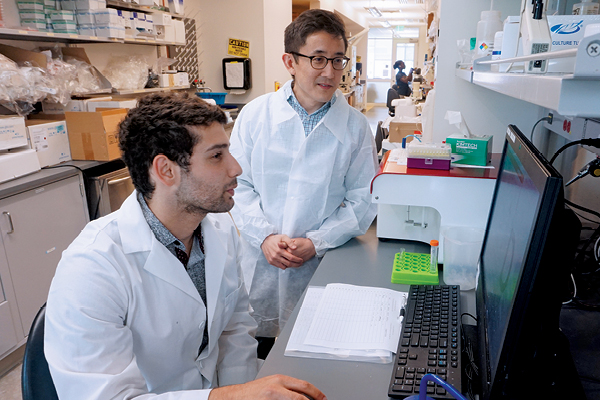A Glimpse into the Future of Cancer Screening

A multi-cancer early detection (MCED) test for general screening could help find more cancers earlier and potentially save lives.
But aside from five cancers with approved screening tests—colonoscopy for colorectal cancer, Pap smears and HPV tests for cervical cancer, mammograms for breast cancer, low-dose CT scans for lung cancer and PSA tests, often along with digital rectal exams, for prostate cancer—there are no effective screening methods for other types of cancer, much less a single test that can detect multiple cancers.
The most widely adopted approach to tackling this grand health challenge mainly focuses on the identification of markers released by tumor cells, such as cell-free DNA and proteins, in the blood or other bodily fluids to spot early signs of cancer. But the trouble is that these tumor markers are present in such vanishingly small quantities that it can be difficult, if not impossible, to distinguish early signs of cancer from normal healthy tissue.
For instance, one of the most promising methods for multi-cancer screening involves ultra-sensitive sequencing of circulating tumor DNA, which is released into the blood from dead or dying cancer cells. Yet, regulatory agencies do not currently recommend these commercially available tests for routine use, as they have been inadequate in detecting cancer at its earliest and most treatable stages in patient studies.
Over the past decade, my research team and I have introduced a radically new approach to early cancer detection based on bioengineering sensors to query tissues. Instead of searching for rare biomarkers in blood, we deploy these tiny sensors throughout the body to hunt for cancer cells, producing a signal that can be easily identified in samples like urine that would otherwise not be present in healthy individuals.
These sensors are activated when they encounter cancer enzymes that are overexpressed by nascent tumors as they grow and invade surrounding tissues. These enzymes act as a biological switch, turning on the sensors to amplify the release of a synthetic biomarker that can rise to far higher levels than natural tumor markers. This gives us a much stronger signal to detect cancer, improving the likelihood of finding cancer early. In preclinical cancer models, synthetic biomarkers were found to outperform native biomarkers, including circulating tumor DNA, making it possible to detect cancer much earlier.

Gabe Kwong (standing) with Ali Zamat
Photo credit: Jerry Grillo/Georgia Tech
What’s next?
Where do we go from here? It turns out that while enzymes make up more than 15% of all human genes, it is not fully understood how their activity differs between various types of cancers and healthy tissue. To change this, we are creating a cancer atlas that focuses on mapping enzyme activity rather than just the abundance of genes, aiming to significantly increase our understanding of the biology of human cancers. We envision that this groundbreaking catalog will pave the way for the development of sensor panels for multi-cancer screening, by helping us pinpoint the best enzymatic signals around which to build future screening tools.
Giant strides are also being made in sensor design. It is now possible to create sensors that implement computer logic, such as the “AND” operation. Just as you need both a username and password to access your account, these logic-based sensors require multiple enzymatic inputs, occurring at the same location within the body, to unlock a detection signal. This level of precision means that these sensors are adept at avoiding false signals, like those that could be caused by common illnesses such as the flu, to reduce the chances of misdiagnosis. In other words, it adds an extra layer of accuracy, helping to ensure that the detected signal is caused by cancer, and not by something else.
Perhaps the most enabling aspect of our approach is that it paves the way forward to engineer bespoke screening tests tailored to specific requirements. For instance, these sensors can be paired with different carriers to target different parts of the body. They can be designed to produce signals in the blood, urine or breath samples, which can then be detected using ultrasensitive lab equipment, or low-cost paper tests for point-of-care use in resource-limited environments. There are even successful examples of genetically engineered immune cells designed to function as living sentinels for cancer detection—these special cells essentially patrol the body and flag the presence of cancer.
As these sensors move closer toward human use, their safety will need to be carefully and rigorously evaluated. A multi-screening test for widespread use needs to be safe for routine administration and should not provoke an immune response that could neutralize the sensors or prevent future reuse. Additionally, the clinical entry point will need to be carefully selected to minimize risk and demonstrate early success of the technology. Demonstrating success in detecting early responses to common cancer drugs or recurrence in patients in remission could expedite large-scale deployment for MCED screening.
While much work remains, technological advancements are rapidly accelerating at an incredible pace to meet the challenge soon. Imagine a future where we can screen for multiple types of cancer at their earliest stages, picking up where current tests fall short. Picture a world where the success of early cancer screening leads to better treatment outcomes, longer patient lifespans and a reduced economic burden on our health care system. The future of multi-cancer screening is on the horizon, and it is closer than ever.





